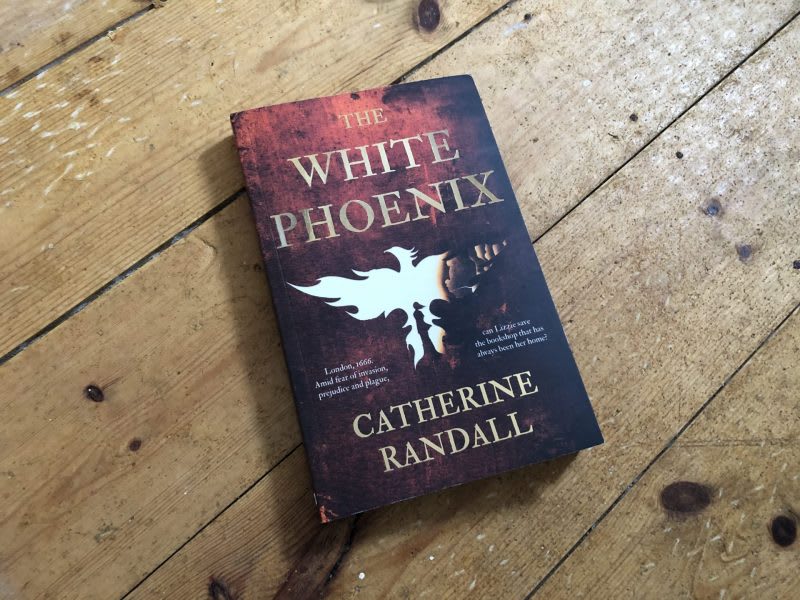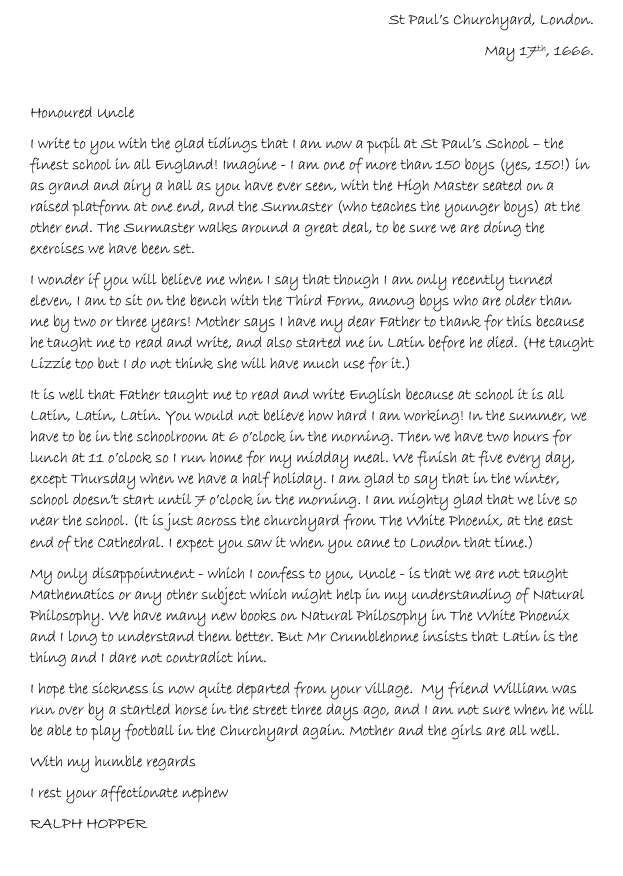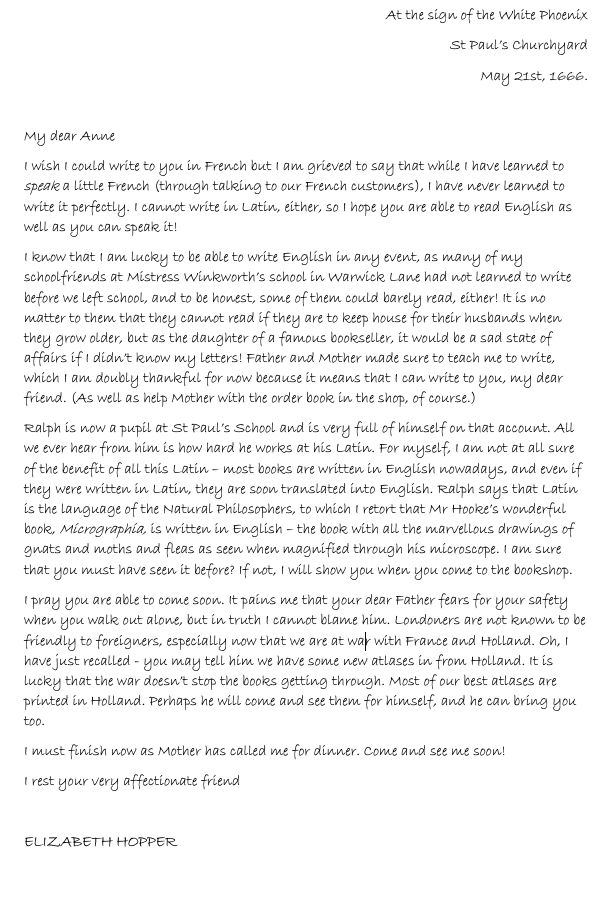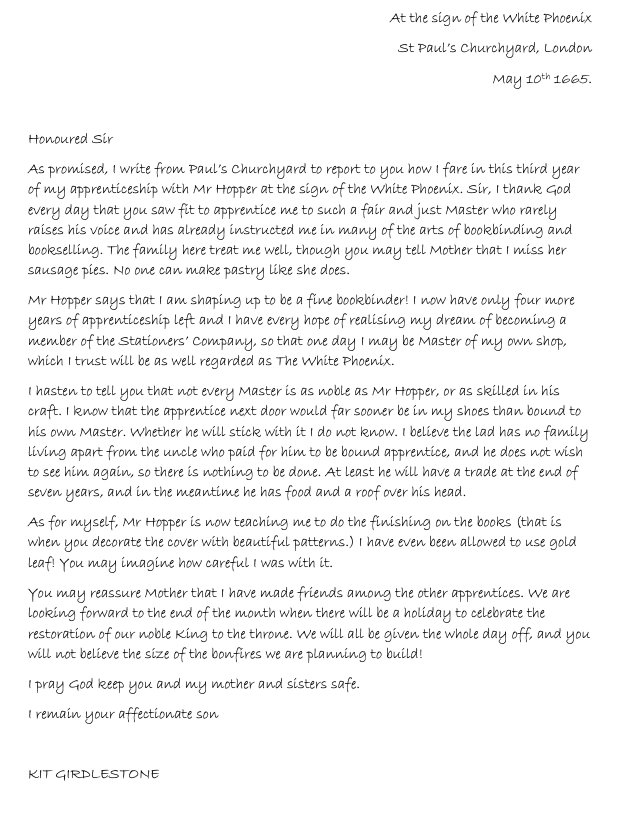The White Phoenix by Catherine Randall: Review and Exclusive Education Resources

In 1666 the Great Fire of London devastated homes, businesses and a large number of famous landmarks as it swept through the city. Catherine Randall’s enthralling historical novel The White Phoenix vividly brings London and its inhabitants to life in the months leading up to the fire.
Set against the backdrop of plague and the war with France, we meet thirteen-year-old Lizzie Hopper and her family. They own a bookshop called The White Phoenix that stands in the shadow of St. Paul’s Cathedral. After personal tragedy strikes, the family must fight to keep their business and protect those closest to them.
Lizzie is a headstrong young woman whose sense of injustice and determination to stand up for those around her makes her a wonderful protagonist. We see her city through her eyes and she is our guide to its streets. I particularly loved accompanying her on a visit to see the lions that were kept on public display at the Tower of London. She is fiercely protective of her bookshop and wants to prove that women are capable of running their own businesses without relying on men to do it for them.
When she meets Anne, the daughter of a wealthy French patron of the shop, they begin a secret friendship that risks leaving Lizzie open to accusations of sympathising with the enemy and betraying her country. But she is a determined heroine and a loyal friend who is prepared to risk serious trouble to protect Anne and to do what is right.
Thoroughly researched and beautifully crafted, this book is filled with history and educators will find much to discuss with their students. It is the story of a city at a moment in time and it shows the different layers of society, the international conflicts, and the impact of the plague on the lives of ordinary people. The bookshop itself in one of the stars of the story. The hustle and bustle of the shop and the roles occupied by the people who work inside gives the reader a wonderful insight into the bookmaking industry of the time. It also highlights the roles of women and the opportunities provided by access to apprenticeships and education.
One of the things that struck me first about the book is how unusual it is to be invited into a novel based in the seventeenth century. Even though the Great Fire is such a significant event in our history curriculum, it is rare to find a book that conjures this particular period of time and Randall evokes the sights and sounds of the period magnificently.
When the fire ultimately strikes, all the panic, anger and confusion of the event are brought to life on the pages and we join Lizzie as she witnesses the horrors of the day and fights to salvage what she can from the bookshop as the fire closes in. But will she also be able to find out who she can trust and save her friends?
Perfectly paced but packed with intrigue and adventure, this book is a wonderful way to explore the past.
You can find out more about Catherine Randall, her work and her in-person events at catherinerandall.com.
The White Phoenix is available at all good bookstores and you can buy it online from bookshop.org.
Free Educational Resources
Catherine has very kindly written some free literacy and history education resources exclusively for The Historian Next Door. These three letters from the main characters describe their lives, their educations, and their hopes. They are available below and are suitable for KS2 and KS3 pupils. They can be supplemental activities for those engaging with the book or for thsoe who are exploring society in seventeenth century England around the time of the Great Fire of London.
(Copyright belongs to Catherine Randall)
Suggested activities:
- Examine what the letters tell us about the lives and opportunities for young people during the second half of the seventeenth century.
- Imagine yourself in London in the months before the Great Fire of London? Write a letter describing your life. Where do you live? Do you go to school? Are you an apprentice? What is helping or preventing you from doing the things you would like? What are your worries and hopes for your future?
- Write a reply to any of the characters from the book describing the differences in your twenty-first century education and what you want to do after you finish your education? Are there any similarities with their lives?
Thanks to Catherine Randall for taking the time to share her expertise and create these brilliant resources.
Letter from Ralph to his Uncle

Notes for Teacher/Parents
1. As you can see from Ralph’s letter, the boys were arranged in classes according to ability rather than age. The boys were seated on benches, also known as forms, so this is why in some schools they still call classes ‘forms’, eg First Form, Second Form etc. When you went up a class at St Paul’s, you literally moved from one bench (form) to another.
2. You will be glad to know that Ralph would have had holidays at Christmas, Easter and Whitsun (in May), but he didn’t have a summer holiday! The Christmas holiday was the longest.
3. It’s hard to believe today, but as Ralph says, most schools only taught Latin, and then some Greek and Hebrew at the top of the school. There was no study of English writers like Shakespeare and no maths or science.
4. ‘Natural Philosophy’ – we would call this science nowadays. At this time, it mainly consisted of trying to understand how the world works through very careful and intelligent observation. The 1660s were a very exciting time for the development of science.
5. Samuel Cromleholme was the High Master of St Paul’s when Ralph was there. In those days, people often spelt their names slightly differently at different times, so Ralph isn’t necessarily spelling the name wrong.
Letter from Lizzie to Anne

Notes for Teacher/Parents
1. In my novel, The White Phoenix, Lizzie makes friends with Anne, a French girl living in London with her father, a merchant who also loves books.
2. Most girls would only go to school until the age of about ten or eleven, and it wasn’t considered important for them to be able to read or write. Children (both boys and girls) from very poor families wouldn’t go to school at all. Boys like Ralph might carry on in education for longer, but the curriculum was very limited (mainly Latin, as we have seen!)
3. Reading and writing were taught separately, unlike today, so many people could read but not write.
4. If you look up Micrographia by Robert Hooke on the internet, you can see the wonderful drawings that Lizzie is referring to. This would have been the first time that anyone had seen what these objects look like when magnified. The flea is quite scary! My Dad had a reproduction copy of the book when I was a child, and I was completely fascinated by the flea.
5. It is often forgotten that England was at war with France and Holland in 1666, and there were several big sea battles that year. Anne’s father was right to be worried about Anne walking round London on her own, especially as her clothes and hairstyle would have given her away as French. I am sorry to say that in 1666 Londoners in general were not at all friendly to foreigners, even when they weren’t at war with them. Lizzie and her family were unusual in being far more open-minded about foreigners than the London crowds. Samuel Pepys, the famous diarist, was also unusual in being very tolerant.
6. Although Lizzie is good friends with Anne, it would have been usual for her to sign off her letter in this formal manner.
Letter from Kit to his father in Surrey

Notes for Teacher/Parents
1. Apprentices served a seven-year contract with their masters, during which time the only holidays they were permitted were public holidays, such as the one marking the anniversary of Charles II’s restoration to the throne on 29 May. Kit’s family lived outside London, so he probably wouldn’t have seen them since he was apprenticed at the age of fifteen.
2. If you completed your apprenticeship successfully, then you would be admitted to the relevant City Livery Company, in Kit’s case, the Worshipful Company of Stationers. This showed that you had completely mastered your craft and meant you could practise your trade within the City of London. Most apprentices served their apprenticeship in London, which made it the biggest training centre in England in the seventeenth century.
3. Many apprentices did not complete their training, but in most cases they parted on friendly terms with their Masters. However, for people like Sam, the apprentice next door to Kit, things were more difficult because he had nowhere to go apart from serving out his apprenticeship. He couldn’t just go and apprentice himself to someone else, because the Masters were paid for taking on apprentices and Sam wouldn’t have had any money himself. Masters didn’t pay their apprentices anything, but they did agree to feed, clothe and train them for the seven years.
4. Londoners celebrated many public holidays by building large bonfires in the streets, and the apprentices would have enthusiastically taken part in this. Considering the houses were mostly made of wood and the streets were narrow, it seems a rather strange thing to have done! Although we don’t tend to do it so much nowadays, I know that they built bonfires in our town to celebrate the end of the Second World War in 1945.
Disclaimer: This page contains affiliate links to bookshop.org and will redirect you to their website. If you make a purchase I will make a very small commission at no extra cost to you and they also share their profits with independent bookshops around the UK.